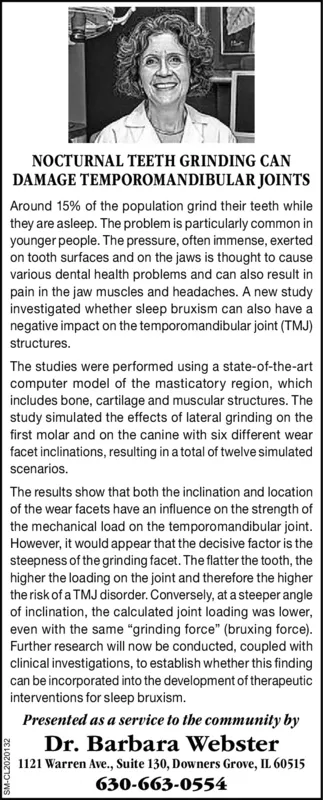Advertisement

-
Published Date
October 5, 2022This ad was originally published on this date and may contain an offer that is no longer valid. To learn more about this business and its most recent offers, click here.
Ad Text
NOCTURNAL TEETH GRINDING CAN DAMAGE TEMPOROMANDIBULAR JOINTS Around 15% of the population grind their teeth while they are asleep. The problem is particularly common in younger people. The pressure, often immense, exerted on tooth surfaces and on the jaws is thought to cause various dental health problems and can also result in pain in the jaw muscles and headaches. A new study investigated whether sleep bruxism can also have a negative impact on the temporomandibular joint (TMJ) structures. The studies were performed using a state-of-the-art computer model of the masticatory region, which includes bone, cartilage and muscular structures. The study simulated the effects of lateral grinding on the first molar and on the canine with six different wear facet inclinations, resulting in a total of twelve simulated scenarios. The results show that both the inclination and location of the wear facets have an influence on the strength of the mechanical load on the temporomandibular joint. However, it would appear that the decisive factor is the steepness of the grinding facet. The flatter the tooth, the higher the loading on the joint and therefore the higher the risk of a TMJ disorder. Conversely, at a steeper angle of inclination, the calculated joint loading was lower, even with the same "grinding force" (bruxing force). Further research will now be conducted, coupled with clinical investigations, to establish whether this finding can be incorporated into the development of therapeutic interventions for sleep bruxism. Presented as a service to the community by Dr. Barbara Webster 1121 Warren Ave., Suite 130, Downers Grove, IL 60515 630-663-0554 SM-CL2020132 NOCTURNAL TEETH GRINDING CAN DAMAGE TEMPOROMANDIBULAR JOINTS Around 15 % of the population grind their teeth while they are asleep . The problem is particularly common in younger people . The pressure , often immense , exerted on tooth surfaces and on the jaws is thought to cause various dental health problems and can also result in pain in the jaw muscles and headaches . A new study investigated whether sleep bruxism can also have a negative impact on the temporomandibular joint ( TMJ ) structures . The studies were performed using a state - of - the - art computer model of the masticatory region , which includes bone , cartilage and muscular structures . The study simulated the effects of lateral grinding on the first molar and on the canine with six different wear facet inclinations , resulting in a total of twelve simulated scenarios . The results show that both the inclination and location of the wear facets have an influence on the strength of the mechanical load on the temporomandibular joint . However , it would appear that the decisive factor is the steepness of the grinding facet . The flatter the tooth , the higher the loading on the joint and therefore the higher the risk of a TMJ disorder . Conversely , at a steeper angle of inclination , the calculated joint loading was lower , even with the same " grinding force " ( bruxing force ) . Further research will now be conducted , coupled with clinical investigations , to establish whether this finding can be incorporated into the development of therapeutic interventions for sleep bruxism . Presented as a service to the community by Dr. Barbara Webster 1121 Warren Ave. , Suite 130 , Downers Grove , IL 60515 630-663-0554 SM - CL2020132
